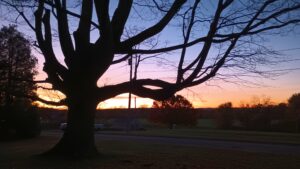Today is my favorite Jewish holiday, Tu B’shevat, The New Year of the Trees.
Why do I like this holiday so much? It doesn’t have a back story about war and destruction or about celebrating a so-called “victory” after taking sides. It’s simply about celebrating trees. And I have a thing for trees.
Nine years ago on Tu B’shevat, my friends and I gathered to have a 100th birthday party for the tree in my front yard, which we know was planted in 1916 when our house was moved several hundred feet by horse and winch from where it previously stood. It’s definitely an elder now and we watch it every year with loving care. We’re glad it’s still standing.

And five years ago, on Tu B’shevat, I was at the Brownsville/Matamoros border, leading writing workshops for women and teenagers who were stuck waiting in Mexico for a months or years to be called for a tiny number of daily asylum appointments. As a prompt for the workshop, we read a book called Somos Como las Nubes, (We Are Like the Clouds), a collection poems by young people about their journey north and their hopes and dreams of a better life.
These children (and the adults that accompanied them) may have thought they were like the clouds. But they were also like trees. Rooted in an unshakable hope. Then and now, I am amazed at their steadfastness and resilience, especially as I think back on the stories they told me of the violence they faced. I continue to be haunted by the pictures on their phones they showed me of loved ones covered in blood.
Friends, these are the stories of many of the people who are being rooted out, separated from their families, shackled and put on planes, or sent to places like Guantanamo Bay.
It breaks my heart. And while it doesn’t minimize the impact of the wrongs being done, I take small solace that trees are still standing.
In fact, when I start feeling anxious and fearful about the end of democracy, I think of the trees all over the world who have lived through wars, genocide, dictatorships…
How do they do it, and what lessons can I learn from them?
It’s only been in the past few years that I read that trees communicate with each other through a complex underground network of fungi to warn each other against insect attacks and other dangers. Somehow, I don’t think they discriminate about which trees to warn and which not to warn, which to welcome, and which to keep out.
Trees, like humans, need community. And tonight, I will celebrate Tu B’shevat tonight in community, where we’ll eat different kinds of tree products (fruit and nuts) and talk about the cycles of life and the seasons. But mostly what I’ll celebrate is that trees are still here–and we’re still here, which I’ve learned has become a theme song on many people’s “getting through dark times” playlists. As a total luddite when it comes to pop culture, I’m not even sure which I’m Still Here song is getting all the play. But here’s a rap I found that I like by Lathan Warlick; and here’s a Holly Near favorite with the slightly altered title of We’re Still Here.
Let’s keep on being here–warning each other against danger, and taking care of each other.
Subscribe at https://ddinafriedman.substack.com
